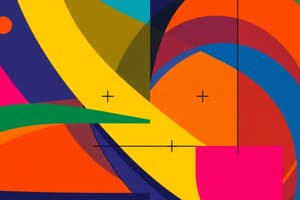Podcast
Questions and Answers
In which field are permutations and combinations used to analyze the structure of networks?
In which field are permutations and combinations used to analyze the structure of networks?
- Probability theory
- Statistics
- Computer science
- Graph theory (correct)
What type of problems involve finding the number of ways to distribute items among groups?
What type of problems involve finding the number of ways to distribute items among groups?
- Password security problems
- Combinatorial problems (correct)
- Genetics problems
- Graph theory problems
What is the main application of permutations in password security?
What is the main application of permutations in password security?
- Determining possible password combinations (correct)
- Determining the length of the password
- Encrypting the password
- Ensuring password uniqueness
Which concept is used to find the number of ways to arrange objects where the order does not matter?
Which concept is used to find the number of ways to arrange objects where the order does not matter?
What mathematical notation is commonly used to denote factorials?
What mathematical notation is commonly used to denote factorials?
If you have a menu with 8 items and you want to choose any combination of 4 items, how many possible combinations can you create?
If you have a menu with 8 items and you want to choose any combination of 4 items, how many possible combinations can you create?
In a tournament with 12 teams, how many ways can you form a team of 5 players each for a match?
In a tournament with 12 teams, how many ways can you form a team of 5 players each for a match?
When selecting 3 books from a shelf with 7 different books, how many ways can you arrange them if the order matters?
When selecting 3 books from a shelf with 7 different books, how many ways can you arrange them if the order matters?
If you have 6 different colored balls and you want to choose 3 balls, allowing for repetition, how many different combinations are possible?
If you have 6 different colored balls and you want to choose 3 balls, allowing for repetition, how many different combinations are possible?
What is the factorial value of 6?
What is the factorial value of 6?
Flashcards are hidden until you start studying
Study Notes
Permutation and Combination
In mathematics, permutation and combination are two important concepts that deal with the selection of items from a given set. While both concepts are related to the arrangement and selection of objects, they differ in their approach and application.
Applications of Permutations and Combinations
Permutations and combinations are used in various fields, including computer science, statistics, and probability theory. They are essential in solving problems related to the selection, arrangement, and counting of objects. Some common applications include:
-
Password security: In password security, the use of permutations is crucial. For example, if we have a password with 8 characters, we can determine the possible combinations by using permutations.
-
Combinatorial problems: Permutations and combinations can be used to solve combinatorial problems, such as finding the number of ways to distribute items among groups or the number of ways to arrange objects in a specific order.
-
Graph theory: In graph theory, permutations and combinations are used to analyze the structure of networks and to find the number of possible arrangements of nodes.
-
Genetics: In genetics, permutations and combinations are used to analyze genetic data and to determine the probability of certain traits being inherited.
Combinatorial Problems
A combinatorial problem is a problem that involves counting the number of ways to select items from a given set without considering the order of the items. Some common types of combinatorial problems include:
-
Picking a team: If you have a group of 10 players, you can use combinations to find the number of ways to form a team of 3 players without considering the order in which they are chosen.
-
Choosing items from a menu: If you have a menu with 10 items and you want to choose any combination of 3 items, you can use combinations to find the number of possible combinations.
Permutations with Restrictions
Permutations with restrictions involve the selection of items from a given set, where the order of the items matters and certain conditions or restrictions are applied. For example, if you have to choose 3 items from a set of 5 items, but you cannot choose the same item more than once, you can use permutations with restrictions.
Combinations with Repetition
In combinations with repetition, the items can be repeated. This means that if you have a set of 10 items and you want to choose any combination of 3 items, but you can choose the same item more than once, you can use combinations with repetition.
Factorial Notation
Factorial notation is used to represent the product of all positive integers up to a given number. For example, 5! (read as "5 factorial") is the product of all positive integers from 1 to 5, which is 5 × 4 × 3 × 2 × 1 = 120. Factorial notation is used extensively in permutation and combination formulas to represent the number of possible arrangements or combinations.
In conclusion, permutations and combinations are essential concepts in mathematics that are used to solve problems related to the selection, arrangement, and counting of objects. By understanding the differences between permutations and combinations, and the various subtopics within these concepts, you can apply them effectively to solve a wide range of problems.
Studying That Suits You
Use AI to generate personalized quizzes and flashcards to suit your learning preferences.




